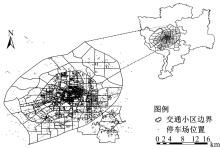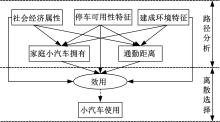Journal of Jilin University(Engineering and Technology Edition) ›› 2019, Vol. 49 ›› Issue (3): 714-719.doi: 10.13229/j.cnki.jdxbgxb20180047
Previous Articles Next Articles
Influence of urban built environment on car commuting considering parking availability
Chao⁃ying YIN1( ),Chun⁃fu SHAO2(
),Chun⁃fu SHAO2( ),Xiao⁃quan WANG1
),Xiao⁃quan WANG1
- 1. MOE Key Laboratory for Urban Transportation Complex Systems Theory and Technology, Beijing Jiaotong University, Beijing 100044, China
2. Key Laboratory of Transport Industry of Big Data Application Technologies for Comprehensive Transport, Beijing Jiaotong University, Beijing 100044, China
CLC Number:
- U491
| 1 | 秦焕美,关宏志,殷焕焕. 停车收费价格对居民出行方式选择行为的影响研究——以北京市居民小汽车、公交、出租车选择行为为例[J]. 土木工程学报,2008,41(8):93⁃98. |
| QinHuan⁃mei,GuanHong⁃zhi,YinHuan⁃huan. A study of the effect of parking price on the mode of inhabitant trip behavior—with the cars, public transit and taxi in Beijing as an example[J]. China Civil Engineering Journal,2008,41(8):93⁃98. | |
| 2 | 丁川,林姚宇,王耀武. 城市空间扩张与机动化水平增长之间的互动关系探究[J]. 交通运输系统工程与信息,2014,14(3):9⁃15. |
| DingChuan,LinYao⁃yu,WangYao⁃wu. Interactive relationship between urban spatial expansion and mobility growth in China[J]. Journal of Transportation Systems Engineering & Information Technology,2014,14(3):9⁃15. | |
| 3 | PetterChristiansen, ØysteinEngebretsen, NilsFearnley, et al. Parking facilities and the built environment: Impacts on travel behavior[J]. Transportation Research Part A: Policy & Practice,2017,95:198⁃206. |
| 4 | GuerraE. The built environment and car use in Mexico city: is the relationship changing over time?[J]. Journal of Planning Education & Research,2014,34(4):394⁃408. |
| 5 | LiSheng⁃xiao, ZhaoPeng⁃jun. Exploring car ownership and car use in neighborhoods near metro stations in Beijing: does the neighborhood built environment matter?[J]. Transportation Research Part D: Transport & Environment,2017,56:1⁃17. |
| 6 | ShirgaokarM. Expanding cities and vehicle use in India: differing impacts of built environment factors on scooter and car use in Mumbai[J]. Urban Studies,2016,53(15):3296⁃3316. |
| 7 | SunB, ErmagunA, DanB. Built environmental impacts on commuting mode choice and distance: evidence from Shanghai[J]. Transportation Research Part D: Transport & Environment,2017,52:441⁃453. |
| 8 | JiangYang, GuPei⁃qin, ChenYu⁃lin, et al. Influence of land use and street characteristics on car ownership and use: evidence from Jinan, China[J]. Transportation Research Part D: Transport & Environment,2017,52:518⁃534. |
| 9 | 曹新宇. 社区建成环境和交通行为研究回顾与展望:以美国为鉴[J]. 国际城市规划,2015,30(4):46⁃52. |
| CaoXin⁃yu. Examining the relationships between neighborhood built environment and travel behavior: a review from US perspective[J]. Urban Planning International,2015,30(4):46⁃52. | |
| 10 | ReidE, RobertC. Travel and the built environment[J]. Journal of the American Planning Association,2010,76(3):265⁃294. |
| 11 | CaoXiao⁃shu, YangWen⁃yue. Examining the effects of the built environment and residential self⁃selection on commuting trips and the related CO2, emissions: an empirical study in Guangzhou, China[J]. Transportation Research Part D: Transport & Environment,2017,52:480⁃494. |
| 12 | WangXiao⁃quan, ShaoChun⁃fu, YinChao⁃ying, et al. Application of Bayesian multilevel models using small and medium size city in China: the case of Changchun[J]. Sustainability,2018,10(2):1⁃15. |
| [1] | Qiao⁃wen BAI,Zhao⁃wei QU,Yong⁃heng CHEN,Shuai XIONG,Chu⁃qing TAO. Modeling on trajectories of through vehicles with an unprotected left⁃turn phase under non⁃strict priority [J]. Journal of Jilin University(Engineering and Technology Edition), 2019, 49(3): 673-679. |
| [2] | Ning⁃bo CAO,Li⁃ying ZHAO,Zhao⁃wei QU,Yong⁃heng CHEN,Qiao⁃wen BAI,Xiao⁃lei DENG. Social force model considering bi⁃direction pedestrian slipstreaming behavior [J]. Journal of Jilin University(Engineering and Technology Edition), 2019, 49(3): 688-694. |
| [3] | Lei CHEN,Jiang⁃feng WANG,Yuan⁃li GU,Xue⁃dong YAN. Multi⁃source traffic data fusion algorithm based onmind evolutionary algorithm optimization [J]. Journal of Jilin University(Engineering and Technology Edition), 2019, 49(3): 705-713. |
| [4] | Qiang TU,Lin CHENG,Fen LIN,Chao SUN. Finding shortest path considering traveler′s risk attitude [J]. Journal of Jilin University(Engineering and Technology Edition), 2019, 49(3): 720-726. |
| [5] | CHEN Yong-heng,LIU Fang-hong,CAO Ning-bo. Analysis of conflict factors between pedestrians and channelized right turn vehicles at signalized intersections [J]. Journal of Jilin University(Engineering and Technology Edition), 2018, 48(6): 1669-1676. |
| [6] | LIU Xiang-yu, YANG Qing-fang, KUI Hai-lin. Traffic guidance cell division based on random walk algorithm [J]. Journal of Jilin University(Engineering and Technology Edition), 2018, 48(5): 1380-1386. |
| [7] | LIU Zhao-hui, WANG Chao, LYU Wen-hong, GUAN Xin. Identification of data characteristics of vehicle running status parameters by nonlinear dynamic analysis [J]. Journal of Jilin University(Engineering and Technology Edition), 2018, 48(5): 1405-1410. |
| [8] | LUAN Xin, DENG Wei, CHENG Lin, CHEN Xin-yuan. Mixed Logit model for understanding travel mode choice behavior of megalopolitan residents [J]. 吉林大学学报(工学版), 2018, 48(4): 1029-1036. |
| [9] | CHEN Yong-heng, LIU Xin-shan, XIONG Shuai, WANG Kun-wei, SHEN Yao, YANG Shao-hui. Variable speed limit control under snow and ice conditions for urban expressway in junction bottleneck area [J]. 吉林大学学报(工学版), 2018, 48(3): 677-687. |
| [10] | WANG Zhan-zhong, LU Yue, LIU Xiao-feng, ZHAO Li-ying. Improved harmony search algorithm on truck scheduling for cross docking system [J]. 吉林大学学报(工学版), 2018, 48(3): 688-693. |
| [11] | CHEN Song, LI Xian-sheng, REN Yuan-yuan. Adaptive signal control method for intersection with hook-turn buses [J]. 吉林大学学报(工学版), 2018, 48(2): 423-429. |
| [12] | SU Shu-jie, HE Lu. Transient dynamic congestion evacuation model of pedestrian at walk traffic planning crossroads [J]. 吉林大学学报(工学版), 2018, 48(2): 440-447. |
| [13] | WANG Zhan-zhong, ZHAO Li-ying, JIAO Yu-Ling, CAO Ning-bo. Social force model of pedestrian-bike mixed flow at signalized crosswalk [J]. 吉林大学学报(工学版), 2018, 48(1): 89-97. |
| [14] | HOU Xian-yao, CHEN Xue-wu. Use of public transit information market segmentation based onattitudinal factors [J]. 吉林大学学报(工学版), 2018, 48(1): 98-104. |
| [15] | GAO Kun, TU Hui-zhao, SHI Heng, LI Zhen-fei. Effect of low visibility in haze weather condition on longitudinal driving behavior in different car-following stages [J]. 吉林大学学报(工学版), 2017, 47(6): 1716-1727. |
|



